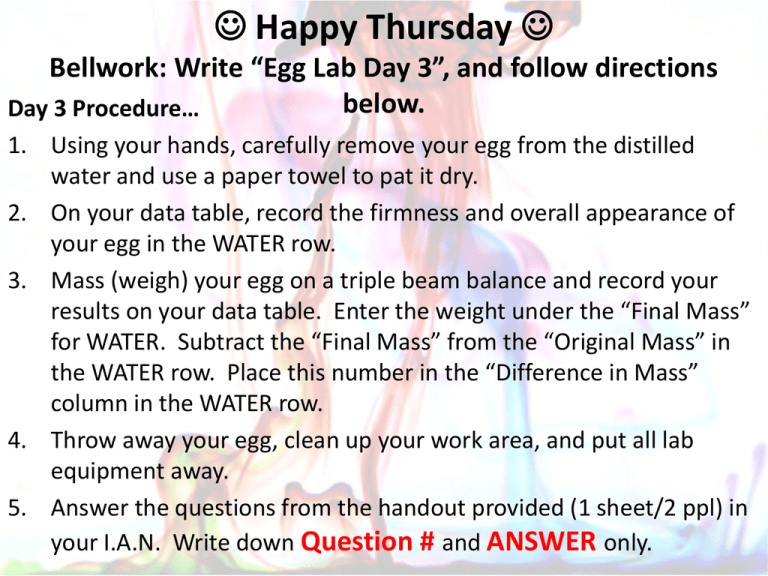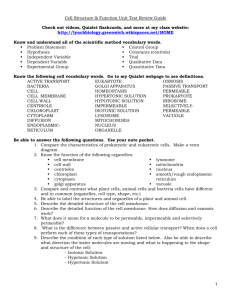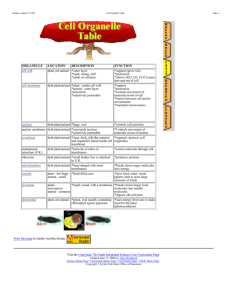B) Water will move from the left to the right.
advertisement

Happy Thursday Bellwork: Write “Egg Lab Day 3”, and follow directions below. Day 3 Procedure… 1. Using your hands, carefully remove your egg from the distilled water and use a paper towel to pat it dry. 2. On your data table, record the firmness and overall appearance of your egg in the WATER row. 3. Mass (weigh) your egg on a triple beam balance and record your results on your data table. Enter the weight under the “Final Mass” for WATER. Subtract the “Final Mass” from the “Original Mass” in the WATER row. Place this number in the “Difference in Mass” column in the WATER row. 4. Throw away your egg, clean up your work area, and put all lab equipment away. 5. Answer the questions from the handout provided (1 sheet/2 ppl) in your I.A.N. Write down Question # and ANSWER only. REMINDERS • I.A.N. Check TOMORROW. • Notecards DUE TOMORROW. • Buff Binder Check on Wednesday • Next week is the last week of st the 1 -Six Weeks. 1) Inside one osmosis bag, A, is a 50% glucose solution and inside bag B is a 20% glucose solution. Both bags are put into beakers containing 100% water. A) Bag A will gain weight. B) Bag B will gain weight. C) Both bags will gain weight. D) Both bags will loose weight. E) Both bags will remain the same. 1) Inside one osmosis bag, A, is a 50% glucose solution and inside bag B is a 20% glucose solution. Both bags are put into beakers containing 100% water. A) Bag A will gain weight. B) Bag B will gain weight. C) Both bags will gain weight. D) Both bags will loose weight. E) Both bags will remain the same. 2) A 0.9% NaCl solution is isotonic to red blood cells. Which of these describes the results if red blood cells are placed into a 9% solution of NaCl? A) They will burst. B) They will shrink. C) Nothing will happen. D) They will expand but not burst. E) None of the above. 2) A 0.9% NaCl solution is isotonic to red blood cells. Which of these describes the results if red blood cells are placed into a 9% solution of NaCl? A) They will burst. B) They will shrink. C) Nothing will happen. D) They will expand but not burst. E) None of the above. 3) The U-shaped tube in the figure below is divided by a membrane that is impermeable to starch but permeable to water. Which of the following will occur? A) Water will move from the right to the left. B) Water will move from the left to the right. C) Starch will move from the right to the left. D) Starch will move from the left to the right. E) Nothing will happen. The membrane blocks the passage of all the molecules. 3) The U-shaped tube in the figure below is divided by a membrane that is impermeable to starch but permeable to water. Which of the following will occur? A) Water will move from the right to the left. B) Water will move from the left to the right. C) Starch will move from the right to the left. D) Starch will move from the left to the right. E) Nothing will happen. The membrane blocks the passage of all the molecules. 4) Wallaway is a new general herbicide for aquatic plants. It is effective against freshwater but not saltwater plants. It works by breaking down the cell walls of the plants. The freshwater plants dies because their cells A) swell and burst. B) shrink and cease to function. C) remain the same size but malfunction. D) are crushed by the weight of the plant. 4) Wallaway is a new general herbicide for aquatic plants. It is effective against freshwater but not saltwater plants. It works by breaking down the cell walls of the plants. The freshwater plants dies because their cells A) swell and burst. B) shrink and cease to function. C) remain the same size but malfunction. D) are crushed by the weight of the plant. 5) A red blood cells has a salt concentration of 0.9%. What will happen if it is placed into a 0.8% salt solution? The red blood cell will A) shrink if its membrane is permeable to both the salt and the water. B) shrink if its membrane is impermeable to the salt and permeable to the water. C) maintain its shape, ie nothing will happen. D) swell and probably burst because its membrane is impermeable to salt and permeable to water. E) swell and probably burst because its membrane is impermeable to water and permeable to salt. 5) A red blood cells has a salt concentration of 0.9%. What will happen if it is placed into a 0.8% salt solution? The red blood cell will A) shrink if its membrane is permeable to both the salt and the water. B) shrink if its membrane is impermeable to the salt and permeable to the water. C) maintain its shape, ie nothing will happen. D) swell and probably burst because its membrane is impermeable to salt and permeable to water. E) swell and probably burst because its membrane is impermeable to water and permeable to salt. 6) Two beakers (below) are connected by a tube partitioned by a membrane permeable to water but not to protein. Which one of the following statements best describes what will happen to this system? A) Water will only move from A to B. B) Water will only move from B to A. C) Water will move equally in both directions so that there will be no net change in the system. D) Water will move in both directions, but the net flow will be from A to B. E) Water will move in both directions, but the net flow will be from B to A. 6) Two beakers (below) are connected by a tube partitioned by a membrane permeable to water but not to protein. Which one of the following statements best describes what will happen to this system? A) Water will only move from A to B. B) Water will only move from B to A. C) Water will move equally in both directions so that there will be no net change in the system. D) Water will move in both directions, but the net flow will be from A to B. E) Water will move in both directions, but the net flow will be from B to A. Essential Question: What is Active Transport and Facilitated Diffusion and do they require energy? CELLULAR TRANSPORT Briefly sketch this experimental set-up. In 30 words, explain why this phenomenon happens. Recap: 1. Osmosis and diffusion do not use energy. The function of protein channels in the cell membrane is to make it easy for certain molecules to cross the membrane. This process is known as facilitated diffusion. (help!) Facilitated diffusion does not require energy. Sometimes cells move materials against a concentration difference. This process is known as active transport. This process requires energy. Active transport is carried out by transport proteins found in the membrane. Endocytosis is the process of taking large amounts of material into the cell by means of enfoldings of the cell membrane. Exocytosis forces contents out of a cell when a vacuole fuses with the cell membrane.





